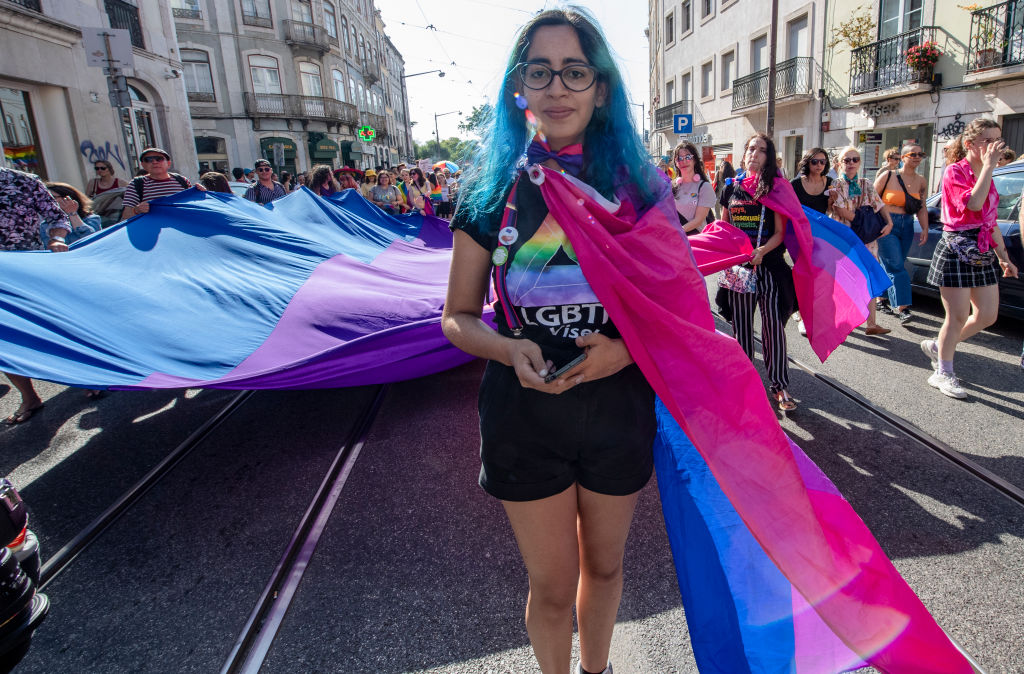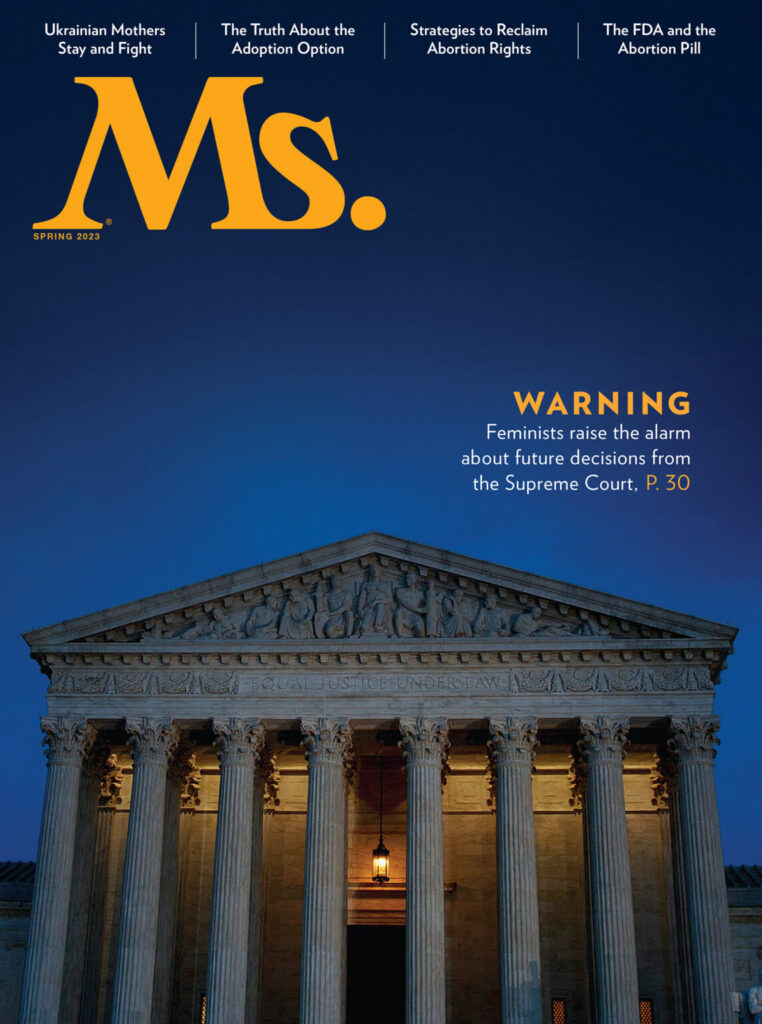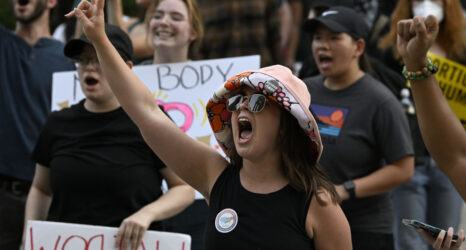
“I felt an attraction to women since junior high, but I didn’t act on it. I was terrified.” When she was growing up in a small town near Grand Rapids, Mich., Aubrey Marron kept her feelings to herself. That changed in 1973 when she left to go to Michigan State University, where she immediately began volunteering at the lesbian center.
“I was helping out with their newsletter and thinking I was gay,” she said.
But it didn’t fit. East Lansing’s lesbian community at that time had little tolerance for women who didn’t reject men entirely, Marron says. Bi people were at best a minority within a minority, even though in 2022 they constituted more than 55 percent of LGBT people, and 75 percent of those polled who identified as bisexual were women.
“The attitude was ‘You’re with us or you aren’t,’ that I was trying to ‘have the best of both worlds,’ and if I was in a relationship with a woman I’d leave her for a guy,” Marron recalled.
Though she didn’t go out of her way to tell others that she’s bi, she didn’t hide it, either. She says the gay men she knew didn’t have any problem with it. But with a lot of straight guys it was different.
“They had fantasies of being with me and another woman,” Marron said. “Bi women are every lesbian’s nightmare and every straight man’s dream.”
Among straight women, the prevalence of rape is 18.7 percent, but among bi women it soars to 46.1 percent.
But men’s fixation on bi women’s sexuality can turn dangerous, as it did for Marron when a male friend violently raped her after finding out that she was bi. He told her it was pointless to report it; he said, smirking, “Who do you think they’re going to believe, you or me?”
She knew he was right.
Fifty years later, little has changed. A 2020 study found that among straight women surveyed, the prevalence of rape is 18.7 percent, but among bi women it soars to 46.1 percent. It’s fueled by a hypersexualization of bi women so widespread that it’s barely noticed. Unless, of course, you’re a bi woman.
Sexuality Isn’t a Performance
“I’ve had young men who, after find- ing out I’m bi, would try to kiss me or touch me in public or send me sexual messages,” said Belle Haggett Silverman, an affiliate of the Boston-based Bisexual Resource Center. “When they hear a woman’s bisexual, they think it means she’s loose, immoral and impulsive.”
Describing her own experiences, Katie Riddle of Chicago added, “I’ve contended with slut shaming or the belief that bi women are just in it for more sex and that bi women just want attention. There’s this assumption that your sexuality is a performance that’s meant to be enjoyed by someone else.”
That’s literally true in the pornography industry, where bi women actors are in high demand.
But hypersexualization isn’t the only threat facing bi women.
Christina Dyar at the Ohio State University is one of a handful of experts who tracks the well-being of the bi community.
“[There are] the stereotypes that it’s just a phase, that it’s not a real sexual orientation and people are in transition to another sexual orientation,” Dyar said.
These myths give rise to discrimination against bi women in the workplace, in school and in other arenas. Such assumptions and others like them are called “bi erasure,” and every time a bi woman encounters this negation, it leaves wounds that over time can have a catastrophic impact on her health. That’s especially true for bi women of color—who comprise 36 percent of all bi women and stand at the crossroads of racism and biphobia.
Walking a Tightrope
Lisa Turner came out when she was 19 and had just moved to Virginia Beach, Va., without any lesbian friends at all. That soon changed when she met players on one of the local women’s softball teams. Two lesbian players, both older, took Turner under their wings.
“They looked after me for a good six months as I started to make my way in the community,” Turner said. “It was a gift.”
But while Turner quickly found friendship and support, bi women in general are more often walking a tightrope without a net. Lacking a community that they can depend on, they face ridicule, discrimination and other abuses entirely on their own. The cost of their isolation can be measured in wide health disparities that separate bi women from others, often with tragic consequences.
Though hampered by a chronic lack of funding, researchers have found that bi women are more likely than the rest of the population to use tobacco and marijuana and become alcohol dependent. Other studies re- port that bi women suffer from high- er rates of asthma and high blood pressure. There’s evidence that bi women experience higher rates of ovarian and other cancers, too. And because bi women can live with “overwhelming anxiety, exhaustion and hopelessness,” they are almost 21 times more likely than straight women to have considered suicide in the prior year, according to the American Psychiatric Association.
It’s a real health crisis—and physi- cians had a hand in creating it.
Wide health disparities separate bi women from others, often with tragic consequences.
Take the Test
Andrea Holland of Sacramento has faced it more times than she can remember.
“When I was dating a woman, I went to my gynecologist for my yearly exam,” she said, “and they wanted to give me a pregnancy test because I told them I wasn’t using birth control. … They told me, ‘You said you’re sexually active but that you’re not on birth control, so we need to double-check.’ I told them I’m dating a woman and they were like, ‘You were dating a man the last time you came in to see us.’ I told them that I haven’t been active with a man since before I had my last period, so ‘I’m telling you I’m not pregnant!’ They didn’t care because I had sex with a man at least one time in the past. They had me take the test.”
“It gets to the point where a bi woman asks herself, ‘Why even both- er?’” Holland added. “Like, ‘I feel a lump. It’s probably nothing. I’m not going to worry about it because I’m just going to have to go through the whole rigamarole.’”
Because of experiences like that of Holland, 33 percent of bi women don’t disclose their sexual identity to physicians. The failure of providers to offer bi-friendly care is one reason bi women have had lower rates of screening for human papillomavirus (HPV), increasing their risk of cervical cancer. Biphobia is so widespread that the American Medical Association has told doctors that “failing to challenge binary sexuality” (read: the assumption that people are either straight or gay) “means enabling some of the most pernicious biphobic stereo
types: that bisexual women are actual- ly closeted lesbian women or straight women going through ‘a phase.’” But the real value of any effort to improve care will depend on how it responds to the needs of the nearly 30 percent of bi women living in poverty, many of them mothers with children.
Moving Ahead
The tidal wave of public support for marriage equality is a turning point for the LGBTQ community. But presenting gays and lesbians as committed monosexuals hasn’t improved the standing of bi people who want relationships that honor their sexuality, not compel them to hide it. Today that’s a bridge too far for most Americans, but change is inevitable. A 2022 Gallup survey found that roughly 21 percent of Generation Z adults who were between the ages of 18 and 23 in 2020 identify as LGBT; 72 percent of those who identify as LGBT say they’re bi. There’s every reason to think they’re going to stay that way. Just ask Aubrey Marron. “I’m 67 years old now,” she said. “I can assure you I’m not going through a phase.”
This article originally appears in the Spring 2023 issue of Ms. Become a member today to read more reporting like this in print and through our app.

Up next:
U.S. democracy is at a dangerous inflection point—from the demise of abortion rights, to a lack of pay equity and parental leave, to skyrocketing maternal mortality, and attacks on trans health. Left unchecked, these crises will lead to wider gaps in political participation and representation. For 50 years, Ms. has been forging feminist journalism—reporting, rebelling and truth-telling from the front-lines, championing the Equal Rights Amendment, and centering the stories of those most impacted. With all that’s at stake for equality, we are redoubling our commitment for the next 50 years. In turn, we need your help, Support Ms. today with a donation—any amount that is meaningful to you. For as little as $5 each month, you’ll receive the print magazine along with our e-newsletters, action alerts, and invitations to Ms. Studios events and podcasts. We are grateful for your loyalty and ferocity.





